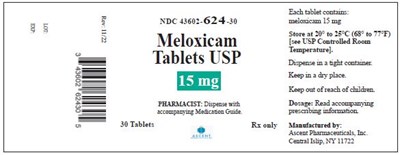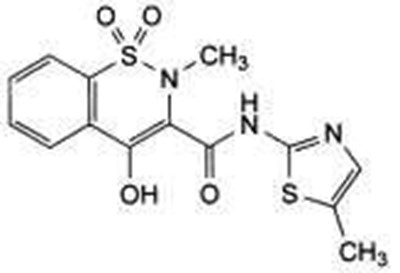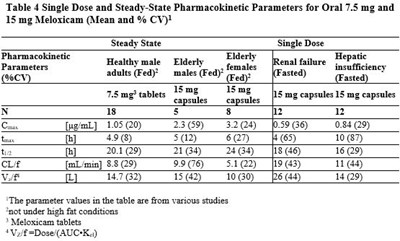Product Images Meloxicam
View Photos of Packaging, Labels & Appearance
Product Label Images
The following 17 images provide visual information about the product associated with Meloxicam NDC 43602-623 by Ascent Pharmaceuticals, Inc, such as packaging, labeling, and the appearance of the drug itself. This resource could be helpful for medical professionals, pharmacists, and patients seeking to verify medication information and ensure they have the correct product.
15 - 15 1000

Product Description: This is a description for a tablet medication called "Mel 15". Each tablet contains an active ingredient called meloxicam in a 15mg dosage. The product is identified with the NDC (National Drug Code) number 43602-624-10 and is manufactured by Ascent Pharmaceuticals, Inc. based in Central Islip, NY. The tablets should be stored in a cool and dry place, at a temperature between 20° to 25° Celsius (68° to 77° Fahrenheit). The packaging is designed to be tight to ensure the freshness and quality of the medication. Pharmacists are advised to dispense the tablets with the accompanying Medication Guide and to keep them out of the reach of children. The dosage instructions should be followed by reading the prescribing information. Please note that the rest of the text is not readable due to issues.*
7.5-1000 - 7.5 1000

This text is a description of a medication called Meloxicam, specifically the tablets with a strength of 7.5 mg. The National Drug Code (NDC) for this medication is 43602-623-10. The pharmacist is instructed to dispense this medication with the accompanying Medication Guide. The package contains 1000 tablets, and each tablet contains 7.5 mg of meloxicam. The recommended storage temperature is between 20° and 25°C (65° to 77°F), and it should be kept in a tight container in a dry place, out of reach of children. The dosage instructions should be obtained from the accompanying prescribing information. The medication is manufactured by Ascent Pharmaceuticals, Inc. in Central Isip, NY 11722.*
MG1 - MG1

This text discusses the potential risks of using Non-Steroidal Anti-Inflammatory Drugs (NSAIDs). It mentions that increased doses and longer use of NSAIDs can have negative effects. It also advises against taking NSAIDs before or after a heart surgery known as a "coronary artery bypass graft" (CABG). Additionally, it suggests avoiding NSAIDs after a recent heart attack unless instructed otherwise by a healthcare provider, as there may be an increased risk of another heart attack.*
MG2 - MG2

This text appears to be a list of risk factors and warnings related to the use of NSAIDs (nonsteroidal anti-inflammatory drugs). The information suggests that the use of NSAIDs may carry a risk of ulcers, bleeding, and potential death. It further lists various factors that may increase the risk, such as a history of stomach ulcers, the use of certain medications (corticosteroids, anticoagulants, SSRIs, SNRIs), increasing doses and longer use of NSAIDs, smoking, drinking alcohol, older age, poor health, advanced liver disease, and bleeding problems.*
MG4 - MG4
This text appears to be describing symptoms that may indicate a medical condition or emergency. It mentions shortness of breath, trouble breathing, slurred speech, chest pain, swelling of the face or throat, and weakness on one side of the body. These symptoms could potentially be signs of a serious health issue and should not be ignored. It is recommended to seek immediate medical attention if experiencing any of these symptoms.*
MG5 - MG5

This text appears to be describing various symptoms that could indicate a health condition. Some of the mentioned symptoms include nausea, fatigue, diarrhea, itching, yellowing of the skin or eyes, indigestion or stomach pain, flu-like symptoms, vomiting blood, presence of blood in bowel movements, unusual weight gain, skin rash or blisters with fever, and swelling of the arms, legs, hands, and feet. These symptoms may be associated with different health issues, and it is recommended to consult a healthcare professional for further evaluation.*
table 1a - table 1a

This is a table showing the percentage of adverse events occurring in a 12-week osteoarthritis trial comparing placebo and active-controlled treatment with meloxicam. The table provides the number of patients in each group (placebo, meloxicam, diclofenac) and the occurrence of various adverse events, such as gastrointestinal symptoms, abdominal pain, diarrhea, accident household, edema, fall, influenza-like symptoms, dizziness, headache, pharyngitis, upper respiratory tract infection, and rash. The table includes specific percentages for each adverse event and compares the results between the different treatment groups.*
table 1b - table 1b

Table 1b provides information on the adverse events occurring in more than 2% of Meloxicam patients in two 12-week placebo-controlled trials for Rheumatoid Arthritis. The table includes the number of patients in each group and the percentages of patients experiencing different adverse events. The adverse events reported include gastrointestinal disorders, such as abdominal pain and dyspeptic signs and symptoms, general disorders and administration site conditions like influenza-like illness, infection and infestations including upper respiratory tract infections, musculoskeletal and connective tissue disorders related to joints, nervous system disorders like headaches, and skin and subcutaneous disorders including rash. The table also mentions the MedDRA preferred terms for some of the adverse events.*
table 2.1 - table 2.1

This text describes potential side effects or symptoms that may be associated with a medication or medical condition. It includes a range of symptoms affecting different systems of the body, such as allergic reactions, fatigue, weight changes, cardiovascular issues (e.g., angina, hypertension), nervous system disturbances (e.g., seizures, tingling), gastrointestinal problems (e.g., ulcers, reflux), heart rate irregularities, blood disorders, liver and biliary issues, metabolic and nutritional imbalances, psychiatric symptoms (e.g., anxiety, depression), respiratory difficulties, skin and appendage issues (e.g., hair loss, rashes), abnormalities in special senses (vision, taste), and urinary system problems.*
table 2 - table 2

Table 2 provides information on the adverse events that occurred in more than 2% of patients taking Meloxicam in 4 to 6-week trials and 6-month trials for osteoarthritis. The table shows the percentages of adverse events for different daily doses of Meloxicam. Adverse events include various gastrointestinal issues, abdominal pain, constipation, diarrhea, dyspepsia, nausea, vomiting, body swelling, and accidents at home. Other adverse events mentioned include edema, dizziness, headache, anemia, muscle pain, back pain, insomnia, coughing, respiratory tract issues, skin problems such as itching and rash, urinary frequency, and urinary tract infection. The text also mentions the combined preferred terms for edema and rash as used by WHO.*
table 3.1 - table 3.1

Tithium (lithium) is a medication that may be affected by the use of NSAIDs (non-steroidal anti-inflammatory drugs) such as meloxicam. Concomitant use of these drugs may increase plasma lithium levels and decrease renal clearance. This effect is attributed to NSAID inhibition of renal prostaglandin synthesis. Patients using meloxicam and lithium should be monitored for signs of lithium toxicity. Methotrexate is another medication that may interact with NSAIDs like meloxicam. Concomitant use of these drugs may increase the risk of methotrexate toxicity, including neutropenia, thrombocytopenia, and renal dysfunction. Therefore, patients using meloxicam and methotrexate should be monitored for signs of methotrexate toxicity. Cyclosporine is a medication that may have increased nephrotoxicity when used concomitantly with meloxicam. Patients using both drugs should be monitored for signs of worsening renal function. Concomitant use of meloxicam with other NSAIDs or salicylates (such as diflunisal and salsalate) increases the risk of gastrointestinal (GI) toxicity without a significant increase in efficacy. Therefore, the concomitant use of meloxicam with other NSAIDs or salicylates is not recommended. Pemetrexed is a medication that can have increased myelosuppression, renal, and GI toxicity when used with meloxicam. Patients with renal impairment and a creatinine clearance of 45 to 79 mL/min should be monitored for myelosuppression and renal and GI toxicity when using meloxicam and pemetrexed. Dosing of meloxicam should be interrupted for at least five days before, the day of, and two days following pemetrexed administration. In patients with a creatinine clearance below 45 mL/min, the concomitant use of meloxicam with pemetrexed is not recommended.*
table 3 - table 3

Table 3 Clinically Significant Drug Interactions with Meloxicam: - Meloxicam and anticoagulants such as warfarin have a synergistic effect on bleeding. The concomitant use of meloxicam and anticoagulants increases the risk of serious bleeding compared to using either drug alone. Monitor patients for signs of bleeding when using meloxicam with anticoagulants, antiplatelet agents, selective serotonin reuptake inhibitors (SSRIs), and serotonin norepinephrine reuptake inhibitors (SNRIs). - The concomitant use of NSAIDs and analgesic doses of aspirin does not produce greater therapeutic effect compared to using NSAIDs alone. However, the combination of an NSAID and aspirin is associated with a significantly increased incidence of gastrointestinal adverse reactions. Concomitant use of meloxicam and low dose aspirin or analgesic doses of aspirin is not generally recommended due to the increased risk of bleeding. Meloxicam should not be used as a substitute for low dose aspirin for cardiovascular protection. - NSAIDs may diminish the antihypertensive effect of ACE inhibitors, angiotensin receptor blockers (ARBs), or beta-blockers. Elderly patients, volume-depleted patients, and those with renal impairment are at increased risk of deterioration of renal function when using NSAIDs with ACE inhibitors or ARBs. Monitor blood pressure and renal function during concomitant use of meloxicam with ACE inhibitors, ARBs, or beta-blockers. - NSAIDs may reduce the natriuretic effect of loop diuretics and thiazide diuretics in some patients. This effect is attributed to the NSAID inhibition of renal prostaglandin synthesis. However, studies with furosemide and meloxicam have not shown a reduction in the diuretic effect. During concomitant use of meloxicam with diuretics, observe patients for signs of worsening renal function and ensure diuretic efficacy. Note: This description is based on the text provided and may not be 100% accurate. It is always recommended to consult the original source or a healthcare professional for complete and accurate information.*
* The product label images have been analyzed using a combination of traditional computing and machine learning techniques. It should be noted that the descriptions provided may not be entirely accurate as they are experimental in nature. Use the information in this page at your own discretion and risk.



